QUEEN OF HEARTS: AUDREY FLACK
…she has been an incredible photorealist, armed with a convincing spray brush. Now, the artist finally gets her due in this documentary. — Nadja Sayej, Forbes
Flack’s bluntness and wry humor is on full display, both about her work and her experiences under the patriarchal confines of the art world. — Dan Schindel, Hyperallergic
…a fascinating examination of a singular artist, a woman who thrived in the nearly completely male-dominated art world of the 50s, changing the demographic and cultural landscape of 20th century art. Anyone who is interested in hearing and seeing first hand the experience of a woman breaking the artistic glass ceiling will find the film compelling, not least because her story comes directly from the source. Audrey Flack is an opinionated, feminist artist who not only continues to create but also to educate young artists. It’s a beautiful thing to know women like her are out there. It’s time her story is being told. — Leslie Combemale, Alliance of Women Film Journalists
A thoroughly engaging documentary portrait of an artist I had never heard of, Queen of Hearts: Audrey Flack, from director Deborah Shaffer and co-director Rachel Reichman is the perfect introduction to its subject, comprehensive in its detail and captivating in its approach. Audrey Flack (born 1931) is still very much of this world, and is our guide, her autobiographical presence supplemented by ample interviews from family, friends and colleagues. In my case, ignorance was truly bliss, as I was able to experience all of Flack’s glory for the first time, the rush of her brilliance hitting me hard. — Christopher Reed, Hammer to Nail
VERY SEMI SERIOUS
A quick-witted treat for New Yorker fans… strikes a pleasing balance between office minutiae and comic greatest hits; she gets enough face time with individual artists to please comedy nerds while keeping things wholly accessible to casual fans. — John Defore, The Hollywood Reporter
Scintillating moments abound… in this breezy and informative documentary. — Glenn Kenny, NY Times
For those of you who read The New Yorker for the illustrations… this all-access look into the weird and wonderful world of cartoon editor Bob Mankoff will be a dream come true. In addition to exploring the history of the magazine’s iconic doodles, Wolchok’s doc is a warm and frequently hilarious portrait of the unique men and women who live for that rare moment when their drawings are printed in their business’ holiest book. — Joshua Rothkopf, Time Out NY
TO BE HEARD
 Three talented high-school students from the Bronx find their voices through a poetry-writing course in TO BE HEARD, a topnotch testimonial to the transformative power of the pen… What could have been a by-the-numbers inspirational lesson is transformed by the brilliance of collaborative filmmaking, the weight of time, the vitality of the kids and the power of their poetry into an exemplary work. —Ronnie Schieb, Variety
Three talented high-school students from the Bronx find their voices through a poetry-writing course in TO BE HEARD, a topnotch testimonial to the transformative power of the pen… What could have been a by-the-numbers inspirational lesson is transformed by the brilliance of collaborative filmmaking, the weight of time, the vitality of the kids and the power of their poetry into an exemplary work. —Ronnie Schieb, Variety
 TO BE HEARD is one of the best documentaries of the year. The film offers more substantive insights into pressing issues of public education and urban poverty than many political commentators muster in a career. TO BE HEARD contains and invites passionate debate… three of the most authentic and complex young adults you’ll find in any film this year. And each is a genuinely great writer: technically accomplished and emotionally overwhelming. They aren’t just the subjects of TO BE HEARD. They’re its stars. —Paul Brunick, New York Times
TO BE HEARD is one of the best documentaries of the year. The film offers more substantive insights into pressing issues of public education and urban poverty than many political commentators muster in a career. TO BE HEARD contains and invites passionate debate… three of the most authentic and complex young adults you’ll find in any film this year. And each is a genuinely great writer: technically accomplished and emotionally overwhelming. They aren’t just the subjects of TO BE HEARD. They’re its stars. —Paul Brunick, New York Times
…authentic sequences leave a real dent in the heart because they are so damned genuine; a great example of good documentary film-making. —Christopher Bell, Indiewire
Simply astounding… what HOOP DREAMS was to basketball, TO BE HEARD is to slam poetry. Both with the same ambition, pathos and sobering reality of its subjects. —Rudie Obias, The Criterion Cast
ASYLUM
The frequently stunning 20-minute award-winning short centers on Baaba Andoh, who sets out to find her long lost father and seek his blessing for her imminent marriage. While her topic may spark shivers of horror among many viewers… Asylum is a powerful, dramatic tale chronicling a young African woman’s tragic entanglement in the choking threads of politics and culture. —Holly Willis, RES Media Group
A heart-wrenching documentary… uses haunting interview photography juxtaposed with vibrant video of the woman’s homeland, Ghana, to create an intimate, yet confrontational tone. —Tim Latorre, Indiewire
FROM THE ASHES: 10 ARTISTS
Deborah Shaffer’s remarkable film FROM THE ASHES: 10 ARTISTS claims to be the first major work about September 11, and part of what makes it work so well is the exactness of its approach. Shaffer shot only the impact of the attacks on a handful of New York City artists…people like performance artist Pat Ozesko who talk through laughter and tears about not knowing how to continue their work… —Christopher Borrelli, The Blade, Toledo, Ohio
FROM THE ASHES: 10 ARTISTS is more about individuals response to September 11 and less about each person’s work. It’s a slice-of-life piece, but the scenes are far from ordinary. —Rachael Mason, Gwinnette Daily Post, Lawrenceville, GA
DANCE OF HOPE
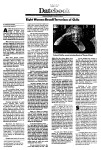 Focusing principally on eight women relating their stories, DANCE OF HOPE offers an impressive picture of their courage, often under threat of police violence. Equally sobering alternatives to the Association members’ tales are those of three women who scour desolate areas in the country’s northland attempting to find the bones of husbands or sons who were known to be executed, but whose burial site has been kept secret by Pinochet’s government. —Dennis Harvey, San Francisco Chronicle
Focusing principally on eight women relating their stories, DANCE OF HOPE offers an impressive picture of their courage, often under threat of police violence. Equally sobering alternatives to the Association members’ tales are those of three women who scour desolate areas in the country’s northland attempting to find the bones of husbands or sons who were known to be executed, but whose burial site has been kept secret by Pinochet’s government. —Dennis Harvey, San Francisco Chronicle
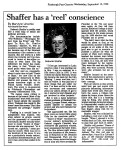 …it is a haunting song by Sting, who invites the women onstage during his Amnesty International concert… that lingers along with the remarkable images. —Marylynn Uricchio, Pittsburgh Post-Gazette
…it is a haunting song by Sting, who invites the women onstage during his Amnesty International concert… that lingers along with the remarkable images. —Marylynn Uricchio, Pittsburgh Post-Gazette
…a no-frills but compelling indictment… DANCE makes its point with a minimum of commentary, allowing juxtaposed images and interviews to do the job. —V.A. Musetto, New York Post
The images repeat themselves. Frame after frame… women dancing the national dance of lovers alone, the frames of their partners gapingly absent… the image is timeless, classic. Shaffer seems weary of looking at loss and asks implicitly when the rest of us will be. —Marcia Pally, 7 Days
FIRE FROM THE MOUNTAIN
 A stirring and informative account of the Sandinista struggle, made up almost exclusively of personal testimonies from Sandinistas… (that are) intelligent and pointed, moving beyond slogans. Music is provided by bassist Charlie Haden. —Jonathan Rosenbaum, Chicago Reader
A stirring and informative account of the Sandinista struggle, made up almost exclusively of personal testimonies from Sandinistas… (that are) intelligent and pointed, moving beyond slogans. Music is provided by bassist Charlie Haden. —Jonathan Rosenbaum, Chicago Reader
 A cross between myth and documentary… Shaffer is able to construct a documentary that is extraordinary — one that is unabashedly partisan and still, at the very same time, one that is informative. Very much like the Vietnam documentary HEARTS AND MINDS, …we see that the “enemy” is little more than a lot of people who look like us, with the same sorts of fears and ambitions, but with a commitment that is undeniable and unshakable. —Ed Kaufman, The Hollywood Reporter
A cross between myth and documentary… Shaffer is able to construct a documentary that is extraordinary — one that is unabashedly partisan and still, at the very same time, one that is informative. Very much like the Vietnam documentary HEARTS AND MINDS, …we see that the “enemy” is little more than a lot of people who look like us, with the same sorts of fears and ambitions, but with a commitment that is undeniable and unshakable. —Ed Kaufman, The Hollywood Reporter
What sets FIRE FROM THE MOUNTAIN apart from other documentaries about recent events in Nicaragua is the literary, at times poetic quality of the eyewitness accounts on the sound track. —Steve Warren, San Francisco Chronicle
WITNESS TO WAR: DR. CHARLIE CLEMENTS
 Asked by a member of the lecture audience how he could reconcile his Quaker beliefs with the violent policies of the rebels with whom he worked, Dr. Clements admits that the question always troubled him though, he emphasizes, he volunteered only to treat civilians and never himself carried arms. WITNESS TO WAR is effective for being as straight forward and direct as the doctor himself appears to be. —Vincent Canby, New York Times
Asked by a member of the lecture audience how he could reconcile his Quaker beliefs with the violent policies of the rebels with whom he worked, Dr. Clements admits that the question always troubled him though, he emphasizes, he volunteered only to treat civilians and never himself carried arms. WITNESS TO WAR is effective for being as straight forward and direct as the doctor himself appears to be. —Vincent Canby, New York Times
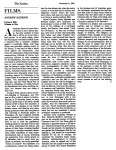 …irony underlies WITNESS TO WAR, Deborah Shaffer’s half-hour report on the unusual journey of Charlie Clements from US Air Force pilot in Vietnam to guerrilla doctor in El Salvador. Clements betrayed his government, though not his country, by opposing its war against the Vietnamese while he was fighting it, and landed in a psychiatric hospital for his act of courage. He continued his treachery (same issues, different Administration) in Central America, when he slipped out of San Salvador into the jungle to help another group of rebels who found themselves at the business end of American guns. —Andrew Kopkind, The Nation
…irony underlies WITNESS TO WAR, Deborah Shaffer’s half-hour report on the unusual journey of Charlie Clements from US Air Force pilot in Vietnam to guerrilla doctor in El Salvador. Clements betrayed his government, though not his country, by opposing its war against the Vietnamese while he was fighting it, and landed in a psychiatric hospital for his act of courage. He continued his treachery (same issues, different Administration) in Central America, when he slipped out of San Salvador into the jungle to help another group of rebels who found themselves at the business end of American guns. —Andrew Kopkind, The Nation
NICARAGUA: REPORT FROM THE FRONT
 Although film makers Deborah Shaffer and Tom Sigel are forthright in their sympathy with the Sandinistas, they let the counter-revolutionaries have their say as well… In the film’s matter-of-fact way, Shaffer and Sigel suggest a highly contemporary form of paranoia at work: every act on the part of a repressed people’s attempt at liberation that’s at odds with our government’s official policy or our economic interests is reflexively labeled Communist… (It) leaves us with the sobering warning that our legacy in Latin America may only be the alienation of a generation of 200 million people. —Kevin Thomas, LA Times
Although film makers Deborah Shaffer and Tom Sigel are forthright in their sympathy with the Sandinistas, they let the counter-revolutionaries have their say as well… In the film’s matter-of-fact way, Shaffer and Sigel suggest a highly contemporary form of paranoia at work: every act on the part of a repressed people’s attempt at liberation that’s at odds with our government’s official policy or our economic interests is reflexively labeled Communist… (It) leaves us with the sobering warning that our legacy in Latin America may only be the alienation of a generation of 200 million people. —Kevin Thomas, LA Times
 …a short, tough, harrowing film containing interviews with key members of Nicaragua’s revolutionary Sandanista Government as well as with key members of the opposition… The filmmakers had access to both sides in the continuing struggle and at one point, accompany a contra raid into Nicaragua. —Vincent Canby, New York Times
…a short, tough, harrowing film containing interviews with key members of Nicaragua’s revolutionary Sandanista Government as well as with key members of the opposition… The filmmakers had access to both sides in the continuing struggle and at one point, accompany a contra raid into Nicaragua. —Vincent Canby, New York Times
EL SALVADOR: ANOTHER VIETNAM
 …a heartbreaking review of recent events in that deeply torn nation, including dramatic interviews with the people in power as well as with opposition leaders, religious and political, some of whom, before the film is over, have been assassinated with the tacit approval of the authorities. No film of this length can do justice to the complexities of the situation, but ”El Salvador” is less concerned with probing issues in depth than in recording the mounting indignation, frustration and terror throughout the land. The anguish expressed is real and profound. —Vincent Canby, New York Times
…a heartbreaking review of recent events in that deeply torn nation, including dramatic interviews with the people in power as well as with opposition leaders, religious and political, some of whom, before the film is over, have been assassinated with the tacit approval of the authorities. No film of this length can do justice to the complexities of the situation, but ”El Salvador” is less concerned with probing issues in depth than in recording the mounting indignation, frustration and terror throughout the land. The anguish expressed is real and profound. —Vincent Canby, New York Times
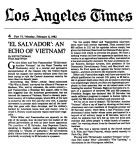 A concise and persuasive documentary. —Los Angeles Times
A concise and persuasive documentary. —Los Angeles Times
 …the film serves as a hard-hitting clarification of the precarious, bloody triangle stretching between the military junta, the peasant freedom fighters, and the U.S. government. —Variety
…the film serves as a hard-hitting clarification of the precarious, bloody triangle stretching between the military junta, the peasant freedom fighters, and the U.S. government. —Variety
…(this film) should be widely distributed and seen by every American who wants to think about the world this country thinks it wants to rule and overrule. It is technically achieved at the highest documentary level (by the filmmakers)… who are probably as lucky to be alive as their audience is fortunate to view their work. —James McCourt, Film Comment
a gripping, compelling film —Bruce McCabe, Boston Globe
THE WOBBLIES
 Stewart Bird and Deborah Shaffer have performed a valuable service in marshaling the combination of interviews and original material ranging from pro-posters to scare-cartoons and old sepia-tone footage and stills. Central exposition is via interviews with surviving Wobblies — the film’s strength really derives from, these folks, the ex-loggers, dockworkers, silkworkers, miners, etc. — the small comforts on the bureaus, the accumulated knickknacks of a lifetime somehow saying more than the text of their memories. —Variety
Stewart Bird and Deborah Shaffer have performed a valuable service in marshaling the combination of interviews and original material ranging from pro-posters to scare-cartoons and old sepia-tone footage and stills. Central exposition is via interviews with surviving Wobblies — the film’s strength really derives from, these folks, the ex-loggers, dockworkers, silkworkers, miners, etc. — the small comforts on the bureaus, the accumulated knickknacks of a lifetime somehow saying more than the text of their memories. —Variety
 THE WOBBLIES is a history of the IWW, researched lovingly and corroborated by the reminiscences of some of the union’s former members, who are now in their 80’s and 90’s. When the facts are presented as fully as they have been here, the feelings that accompanied them aren’t difficult to imagine. —Janet Maslin, New York Times
THE WOBBLIES is a history of the IWW, researched lovingly and corroborated by the reminiscences of some of the union’s former members, who are now in their 80’s and 90’s. When the facts are presented as fully as they have been here, the feelings that accompanied them aren’t difficult to imagine. —Janet Maslin, New York Times
Without any pretense of “objectivity,” Bird and Shaffer not only have resurrected a slice of American history usually buried out of sight in the classrooms, but produced a spirited and exhilarating distillation of that pre-World War I period in 89 minutes. —Judy Stone, San Franiciso Chronicle
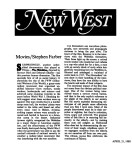 The greatest value of this film is in restoring full humanity to the elderly — not by making them cute old codgers as Hollywood often does but by demonstrating the survival of their tough, rebellious spirit… This vibrant, joyous film celebrates the continuum of history. —Stephen Farber, New West
The greatest value of this film is in restoring full humanity to the elderly — not by making them cute old codgers as Hollywood often does but by demonstrating the survival of their tough, rebellious spirit… This vibrant, joyous film celebrates the continuum of history. —Stephen Farber, New West
 The happiest hit of the New York Film Festival —Harold Clurman, The Nation
The happiest hit of the New York Film Festival —Harold Clurman, The Nation
A vivid look into America’s radical past. Its heroes and heroines are filled with vitality — a rare attribute these days. —Studs Terkel
Pure entertainment… a good ballad, neatly presented. —Film Comment
DEBORAH SHAFFER
![]() Her WITNESS TO WAR: DR. CHARLIE CLEMENTS, about disillusionment with US policy in El Salvador, won an Academy Award last year, and FIRE FROM THE MOUNTAIN, the story of Sandanista guerrilla Omar Cabezas, opens this fall. “It took me a long time to figure out what my films were about. But they’re about conscience and commitment to change.” —Elle
Her WITNESS TO WAR: DR. CHARLIE CLEMENTS, about disillusionment with US policy in El Salvador, won an Academy Award last year, and FIRE FROM THE MOUNTAIN, the story of Sandanista guerrilla Omar Cabezas, opens this fall. “It took me a long time to figure out what my films were about. But they’re about conscience and commitment to change.” —Elle
 It was the “poetic and human quality” of the book (Fire from the Mountain: the Making of a Sandanista by Omar Cabezas) that attracted Shaffer, who prefers to examine social issues through intimate details. “I like to deal with political subjects in a personal way.… People don’t get involved in abstracts, they relate to stories that mean something emotional.” Stories that mean something — call it a woman’s touch — have been Shaffer’s modus operandi throughout (her) career as a documentarian. —Susan Green, Vanguard Press
It was the “poetic and human quality” of the book (Fire from the Mountain: the Making of a Sandanista by Omar Cabezas) that attracted Shaffer, who prefers to examine social issues through intimate details. “I like to deal with political subjects in a personal way.… People don’t get involved in abstracts, they relate to stories that mean something emotional.” Stories that mean something — call it a woman’s touch — have been Shaffer’s modus operandi throughout (her) career as a documentarian. —Susan Green, Vanguard Press
 Chic in a black dress and pearls, her new baby off in her husband’s care for the afternoon, Shaffer doesn’t exactly fit the picture of the radical film maker dashing into Latin American police barricades. But her 20-year-old career in the field started, predictably enough, with dose of late 60’s / early 70’s involvement in U.S. student movements. Involvement with the Newsreel Collective, a national leftist filmmaking / distribution group, got her hooked on the medium as “the perfect marriage of craft and message, the chance to organize people and create discussion.” —Dennis Harvey, San Francisco Chronicle
Chic in a black dress and pearls, her new baby off in her husband’s care for the afternoon, Shaffer doesn’t exactly fit the picture of the radical film maker dashing into Latin American police barricades. But her 20-year-old career in the field started, predictably enough, with dose of late 60’s / early 70’s involvement in U.S. student movements. Involvement with the Newsreel Collective, a national leftist filmmaking / distribution group, got her hooked on the medium as “the perfect marriage of craft and message, the chance to organize people and create discussion.” —Dennis Harvey, San Francisco Chronicle
